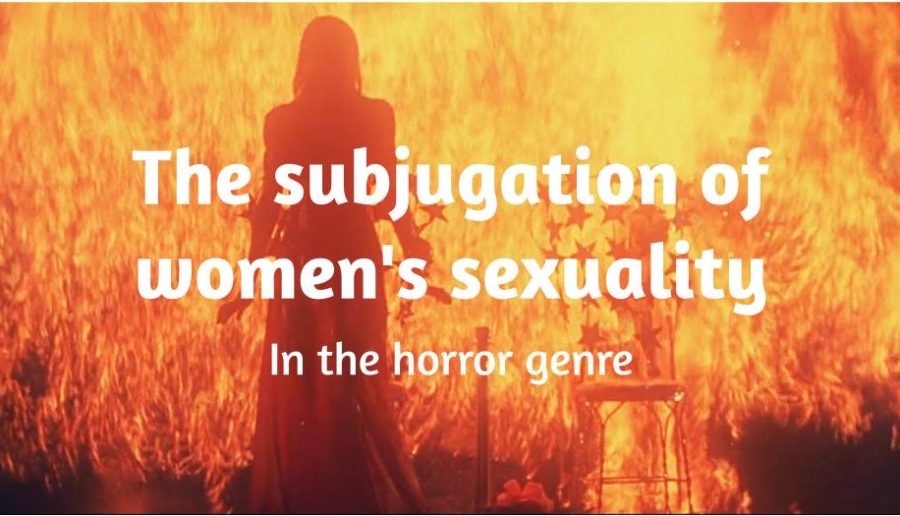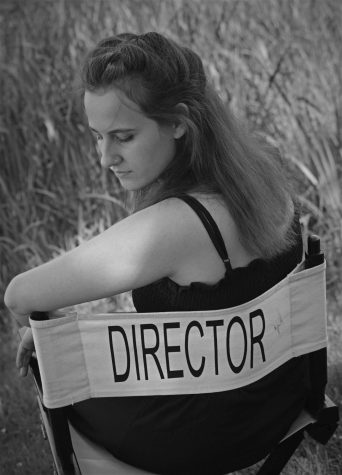The subjugation of women’s sexuality
The horror genre has relied on the punishment and guilt of the sexuality of women for years
November 4, 2022
We all know the basic plot of a typical horror film. A girl is home alone when she suddenly hears a bump in the night, and now suddenly she has a psychotic killer chasing after her for the duration of the film. We’ve seen these predictable horror film plots time and time again.
However, beneath this basic yet effective structure, horror films commonly depict the punishment of female sexuality, thereby making female viewers fearful and guilty of their own sexuality.
The Horror genre is one that explores the subjects of power, gender, and sexuality. Although the genre was one of the first to introduce women as main characters, it wasn’t until much later that they were used for more than being the token female character with no further use than aiding the male pleasure of being a sex figure or killed.
In early horror, women were used as damsels in distress until the slasher genre started to emerge in the 70s which then used women for sexual torture. In slasher films, sex and violence usually go hand in hand. Professors Molitor and Sapolsky conducted a study in 1993 using 30 different slasher films; the study showed that female death scenes were twice as long as male death scenes. The reason for this often being to prolong the torture of woman, by having them beg for their lives most likely while half naked.
Starting in the 90s to current time, the most popular trope for women, as the industry calls it, is the final girl. Most of the time the only reason a final girl survives is due to the fact that she is a virgin, a stereotype that shames women for embracing sexuality. The virgin is usually paired with her stereotypical teenage friend group consisting of a jock, the promiscuous women, the stoner/nerd, and the token racial minority. The stereotypical promiscuous character is usually paired with her jock boyfriend and is used to contrast the pure virgin. The character is usually an attractive girl who is openly comfortable with her sexuality. The promiscuous girl usually ends up dying right after having sex with her jock boyfriend, enforcing the idea that women having and enjoying sex means you should be punished.
Women are constantly being punished for their sexuality in horror. Womanhood is seen as shameful and gross. A perfect example of this comes from the 1976 classic Carrie. The movie follows a young girl named Carrie who is constantly shamed for her journey to becoming a woman. Throughout the movie, Carrie is ridiculed by her religious mother and classmates for common stages of becoming a Woman such as getting her period and her body changing. She’s made out to be a monster for this when in reality she’s just a sheltered girl under constant humiliation.
Another example of a lead female character being made out to be a monster due to her sexuality, is the cult classic Jennifer’s Body. The director’s intention with this film was to appeal to young women while fighting misogynistic traditions. The film follows Jennifer, a normal teenage girl that gets possessed by a demon that likes to eat boys. She becomes this demon after a group of men attempt to sacrifice her to Satan in exchange for fame. The sacrifice fails due to Jennifer not being a virgin, straying away from the trope of the final girl. Although Jennifer’s Body didn’t follow this traditional trope, Jennifer was still made out to be a monster because she had sex, again drilling the idea that women should be punished for having sex.

When looking at all of the most used horror tropes for women, so many shame women for their sexuality. Here’s just three broken down:
You had sex? Guess you have to die:
In many horror films women die after the act of sex. The slasher classic Halloween is one of the first to come to mind that follows this trope. Every female victim of Michael Myers was killed before or after having sex. Women are taught to be scared of sex. Time and time again were shown all these bad things that happen from being sexually active. We’re meant to fear our sexuality and be ashamed while male characters are often encouraged and praised for sleeping around. The double standards for sex is extremely present between women and men in all parts of life. If a woman sleeps with a bunch of people she’s labeled as a slut while a man is applauded for being a player.
Violence on women:
Violence inflicted on women usually while they are half naked or nude is meant to feed into the male desire of female pain and objectification. In many horror movies mostly in the slasher genre, violence on women tends to coexist with sexual nature. There have been multiple studies that have shown that this type of sexually motivated violence againist women has caused male viewers to become more hostile towards women and shift their beliefs and demeanor towards them. According to a study that took place in 2009 by Andrew Welsh from the Department of Criminology, using slasher films released between 1960 and 2007 showed that women are more likely to be victimized in scenes involving sex and violence together.
The pregnant woman:
Sometimes women only exist in a piece of horror media to be made pregnant. They have no other purpose other than carrying a baby. The biggest example of this is Rosemary’s Baby, which follows a young woman named Rosemary who moves into a new apartment building. Then soon suspects her neighbors are a part of a Satanic cult. After rosemary was drugged and raped by one of the neighbors, she becomes pregnant with the child of Satan. She was terrorized and gaslighted throughout the entire movie with no other purpose then carrying the baby and being victimized. She was punished for something she did not consent to and had no choice in.
This information is not meant to make anyone boycott old horror movies. You can still love old horror while also recognizing the inequality between genders during that time and how current horror films are working towards changing that sexism. There is still a lot of work to do; sexism against women in horror is still present even in modern times. However, slowly women are getting more appropriate representation in film. Thankfully there are many new directors such as Ari Aster (director of Hereditary and Midsommar) that are changing the game, making sure women in their films are properly portrayed. Still, when it comes to the genre as a whole, changes need to be made in order for the genre to be fully equal to women.


